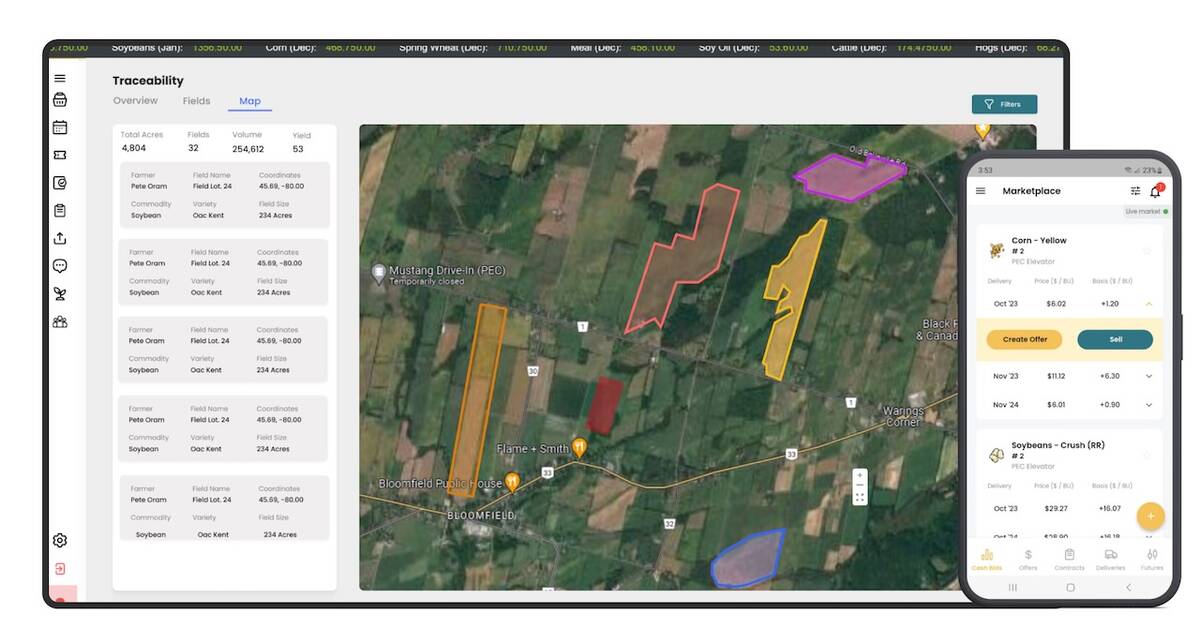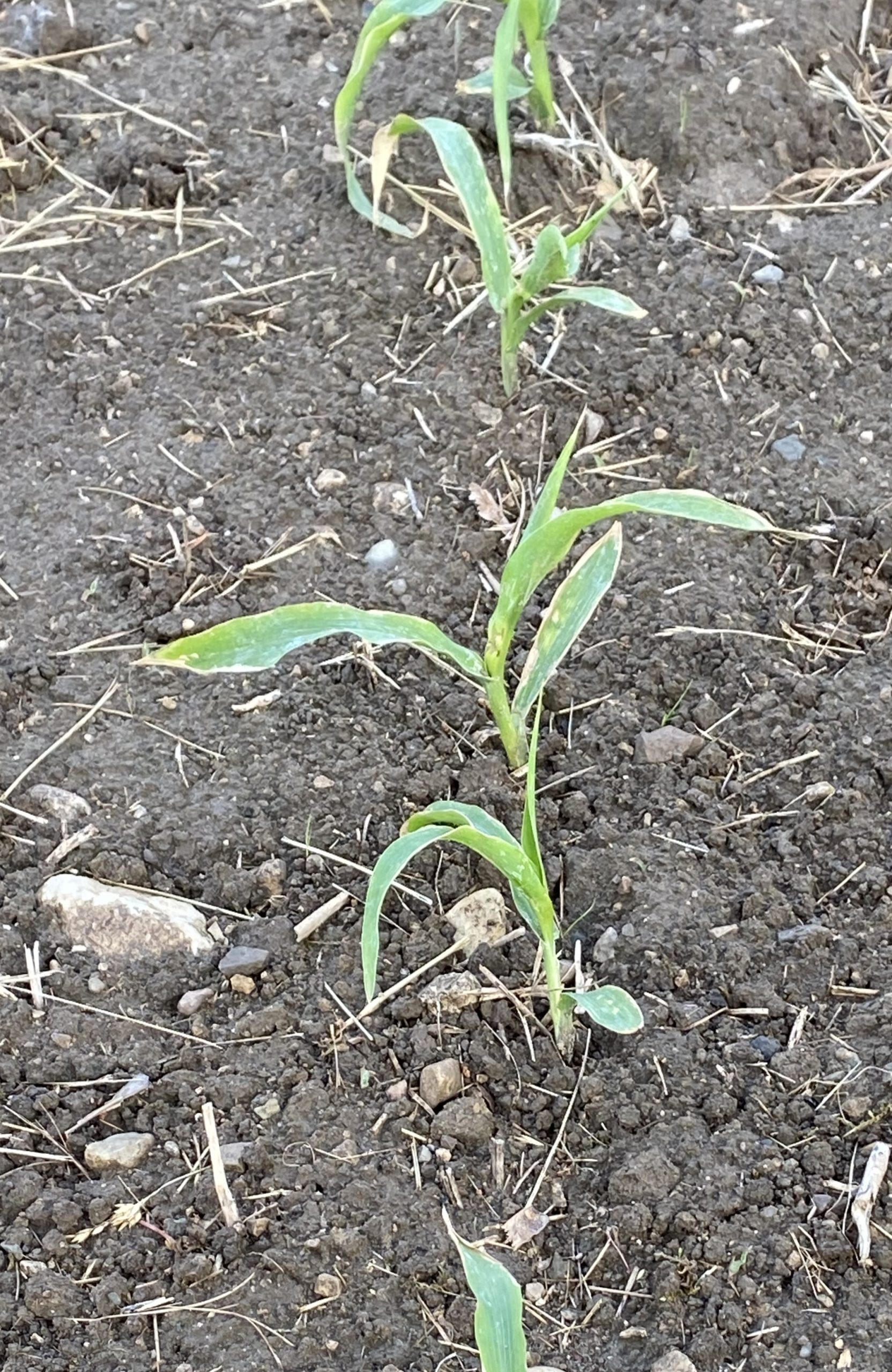A cool, wet spring is prompting some farmers to consider replanting, but most early planted corn and soybeans will likely grow through any stunting and corkscrewing.
With the exception of Northern Ontario, most regions in the province received more than 80 mm of rain in May, with some areas reaching 90 mm. In addition to the wet weather, temperatures continue to remain below average in many regions.
Why it matters: Replanting a field is a big decision as it increases seed and operations costs, but it’s a decision that has to be made quickly.
Read Also

Ontario company Grain Discovery acquired by DTN
Grain Discovery, an Ontario comapny that creates software for the grain value chain, has been acquired by DTN.
Rains have been frequent, but not pounding and heavy, meaning fields are as crusted as they could have been.
“The biggest challenge has been cool temperatures. Growers in some areas had a window to plant early, some mid to late April, and then it turned cold,” said Bob Thirlwall, customer solutions lead, Bayer Canada, Crop Science Division. “Fields were planted in good conditions, but the soil temps dipped, and it made for slow emergence.”
Despite the prolonged cool weather, he said that the company has not seen many issues so far and they remain optimistic about the arrival of warm weather.
“I have walked a few fields with uneven emergence but haven’t seen any crusted fields at this point (May 27, 2025). I have seen some corn plants that are trying to leaf out under the soil surface, and a few that are cork screwed, but very few and the stands are still thick enough that those fields don’t need replanting,” he said.
Regionally, Thirlwall has observed that in the southwest, a few acres of soybeans planted in mid-April had to be replanted, which he feels is the result of cool temps and tight soils after a couple of cool rains.
He added that growers will pull the trigger on replanting as soon as it is determined that “the plants should be up and running.” Thirlwall said that this usually occurs approximately 14 days after planting.
“At that point, we do our population counts to see what has emerged or will emerge in the next few days. For corn, we typically leave stands that have 20,000 to 22,000 plants. For soys, we look for 100,000 to 120,000 plants per acre,” he said.
“For corn replanting, it’s important to take out the plants that are there with either tillage or herbicide and start fresh with new seed at the full population. For soy, growers will just add soybeans to the stand that is there, aiming to get back to a full population accounting for what has already emerged.”
Thirlwall added that unfortunately there is not much that can be done about plants that are coming up too slow.
“A rotary hoe can help in some situations. I have also seen growers use an empty planter to run over the field to try and break up some crust, but as I mentioned, we haven’t really had any crusting this spring,” he said. “What we really need is some sun and warm weather to give the plants a kick-start and get them going.”
Ben Rosser, a corn specialist with OMAFA says the current situation for farmers is a far cry from what they were experiencing a few months ago.
He says planting conditions were great in early spring and planting progressed very quickly.
“I hear there are still pockets of the province, particularly those heavier-textured areas, where rains have been frequent enough or weather has just not been conducive to drying out enough for planting, and there are still some corn acres to go in,” he said adding that while the large majority of corn crop has been planted across the province has or is now emerging, in some of these more local areas some growers could still have a large percentage of their intended corn acres not yet planted.
To assess if a replant is necessary, evaluate the existing stand for population and variability and trying to estimate what the yield potential of that stand may be relative to the yield and economic potential of replanting, says Rosser.
Rosser noted that there can be yield penalties to reduced stands, adding that there are also yield penalties for planting late (replanting) as well as additional costs such as field operations and higher drying costs at harvest.
In most cases, he said, there needs to be a fairly significant reduction in population to warrant a replant, but that it can depend how uniform that population is and what area of the province you are in.
Rosser suggests using the Ontario Corn Replant Decision Aid Tool available from OMAFA’s Field Crop News, https://fieldcropnews.com/tools-for-corn-growers/
It uses Ontario corn population and planting date data to help assist with these decisions.
Regionally, he said there are no significant replants of corn occurring, but he noted it would not be unusual to have some in some regions of Ontario each year.
“I have heard of some local areas where some growers have struggled to get all their intended corn acres in. In these cases it is often areas that have just been catching too many frequent rains, or areas with heavier textured soils that have struggled to dry out enough with the weather we’ve had the last couple weeks,” he said.
He believes that these decisions are likely being made once there is a good handle on what the final population may be through evaluating stands once growers and experts are fairly certain everything that is going to emerge and contribute to yield has emerged.
“In most cases, we would likely have a good handle on what our final stand might be within a week or so after emergence started, but this might depend on what is holding late or non emerging plants back,” he said.
“It’s a bit of a wait and see approach and depends on what is impairing emergence. For example, if crusting is an issue, there might be some options to try and help with emergence. In other cases, such as cold injury or vigour issues, there might not be much that can be done other than replanting.”
He suggests a grain drill can be run across the field to break up the crust.













